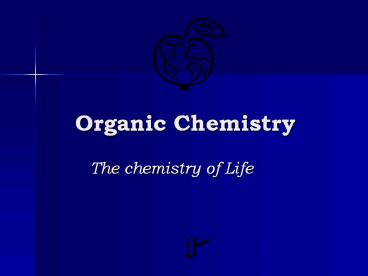Organic Chemistry PowerPoint PPT Presentation
1 / 14
Title: Organic Chemistry
1
Organic Chemistry
- The chemistry of Life
2
What is Organic Chemistry ??
- Organic Chemistry is the chemistry of compounds
containing carbon. - Two common examples are CO2 and CH4 Carbon
dioxide and Methane, respectively.
3
The Versatility of Carbon
- Because of the configuration of electrons of
Carbon. - Carbon can have four covalent bonds.
- Carbon can act as an intersection point from
which a molecule can branch off in up to four
directions. - When carbon has four bonds it creates a
tetrahedron.
4
Versatility of Carbon
- Carbon skeletons can vary in length.
Butane
Pentane
Octane
5
More Carbon Molecules
- Cyclohexane is a type of ringed molecule.
- Carbon can be double bonded as in 1-butene
Ball and Stick Model
Structural Formula
6
HydroCarbons !!
- Hydrocarbons are organic molecules consisting
only of carbon and hydrogen. - Hydrocarbons are the major components of
petroleum
7
Hydrocarbons (continued)
- Hydrocarbon tails are components of fats.
- Neither petroleum nor fat mixes with water.
- Hydrocarbons store a great deal of energy
8
Functional Groups
- Functional Groups are components of organic
molecules that are most commonly involved in
chemical reactions. - Hydroxyl (-OH) -Amino (NH3)
- Sulfhydryl (SH) -Carbonyl (CO)
- Phosphate (PO4) -Carboxyl (C00H)
9
Hydroxyl Group
- In a hydroxyl group, a hydrogen atom is bonded to
an oxygen atom, which in turn is bonded to the
carbon skeleton of the organic molecule. - The molecules are called alcohols
10
Carboxyl Group
- Compounds that contain a carboxyl group are known
as carboxylic acids. - The simplest is formic acid, the substance some
ants inject when they sting.
Ant
Formic Acid
11
Carbonyl Group
- There are two different types of Carbonyl groups
- Aldehydes where the double bond to O is at the
end of the molecule - Ketones where the double bond to O is in the
middle of the molecule.
An Example is Acetone
12
Amino Group
- Organic compounds with this functional group are
called Amines - They are commonly found in Amino Acids.
- Amino Acids are the building blocks of proteins
13
Organic Chemistry Building Blocks Of Life
- All of these functional groups are components to
molecules that join together to make larger more
complex molecules that are called Macromolecules. - Basic formula
- Monomer Monomer Monomer Polymer.
- For example Amino Acid Amino Acid Amino Acid
Protein. - Or, Glucose Glucose Glucose Glucose Starch
14
Macromolecules
- Carbohydrates
- Sugars
- Nucleic Acids
- DNA etc.
- Lipids
- Fats
- Proteins
- Amino Acids

